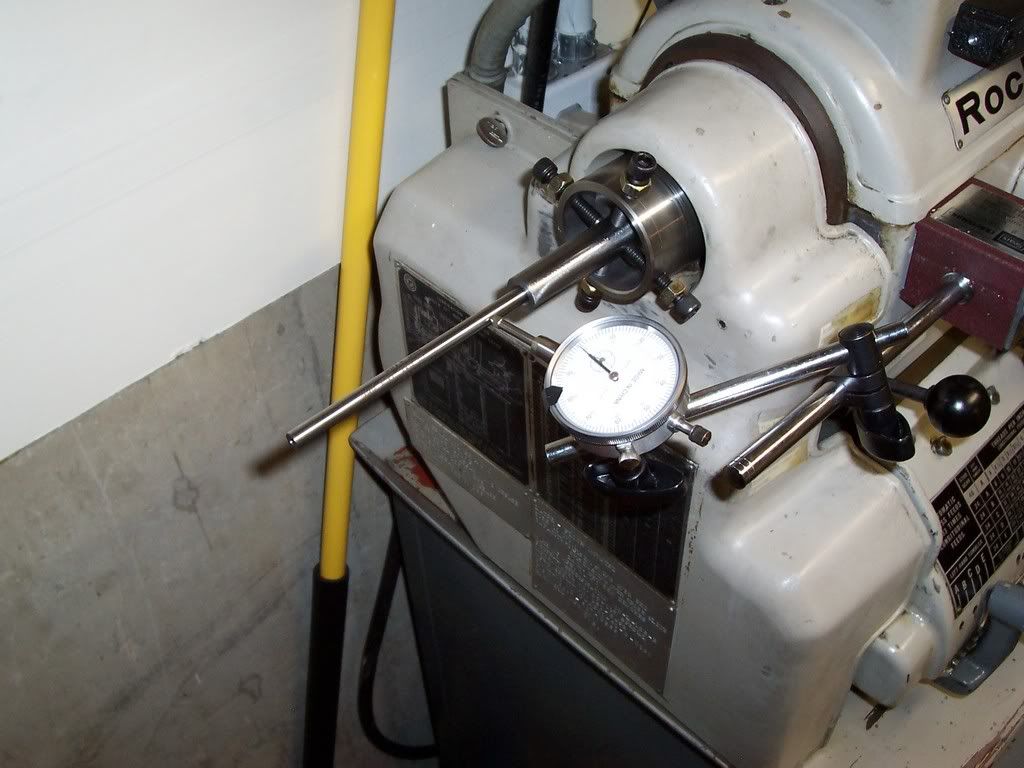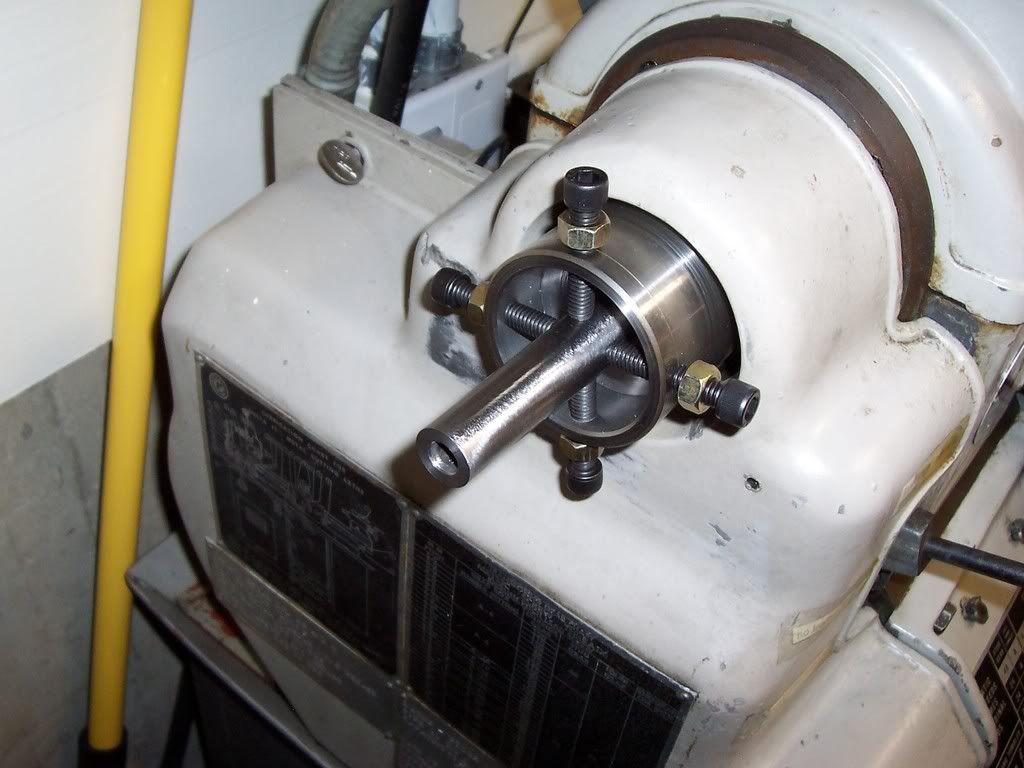Gunsmithing Shortening a barrel
- Thread starter 3wide
- Start date
You are using an out of date browser. It may not display this or other websites correctly.
You should upgrade or use an alternative browser.
You should upgrade or use an alternative browser.
Re: Shortening a barrel
I use PTG Indicator / Rang rods to indicate the bore is running true. This is important on both ends, although its just as easy to indicate on the chamber too.
I work through the headstock on mine.
I use PTG Indicator / Rang rods to indicate the bore is running true. This is important on both ends, although its just as easy to indicate on the chamber too.
I work through the headstock on mine.
Re: Shortening a barrel
<div class="ubbcode-block"><div class="ubbcode-header">Originally Posted By: Rprecision</div><div class="ubbcode-body">I use PTG Indicator / Rang rods to indicate the bore is running true. This is important on both ends, although its just as easy to indicate on the chamber too.
I work through the headstock on mine. </div></div>
When machining the crown, is it necessary to dial in the muzzle end, and the chamber end?
It's a RRA upper with a wilson barrel, good barrel but not super high end, .75moa shooter.
My plan was to put a pin gage in the muzzle end, dial that, then face the crown.
Any tips on making sure their is not burr after facing?
<div class="ubbcode-block"><div class="ubbcode-header">Originally Posted By: Rprecision</div><div class="ubbcode-body">I use PTG Indicator / Rang rods to indicate the bore is running true. This is important on both ends, although its just as easy to indicate on the chamber too.
I work through the headstock on mine. </div></div>
When machining the crown, is it necessary to dial in the muzzle end, and the chamber end?
It's a RRA upper with a wilson barrel, good barrel but not super high end, .75moa shooter.
My plan was to put a pin gage in the muzzle end, dial that, then face the crown.
Any tips on making sure their is not burr after facing?
Re: Shortening a barrel
<div class="ubbcode-block"><div class="ubbcode-header">Originally Posted By: 3wide</div><div class="ubbcode-body"><div class="ubbcode-block"><div class="ubbcode-header">Originally Posted By: Rprecision</div><div class="ubbcode-body">I use PTG Indicator / Rang rods to indicate the bore is running true. This is important on both ends, although its just as easy to indicate on the chamber too.
I work through the headstock on mine. </div></div>
When machining the crown, is it necessary to dial in the muzzle end, and the chamber end?
It's a RRA upper with a wilson barrel, good barrel but not super high end, .75moa shooter.
My plan was to put a pin gage in the muzzle end, dial that, then face the crown.
Any tips on making sure their is not burr after facing? </div></div>
Ok, let me see how I can explain this.
Lets take an imaginary plane, a circular one, call it the bore.
Take this plan and spin it like an axle as if it were in a lathe
What you want is this plane to be perfectly concentric, no run out, spinning perfectly true.
Now since this plane is one piece and connected, lets say you have the chamber on one end with .025” run out. The muzzle end you have set to zero. Because the plane is moving at a eccentric (one end is wobbling) you crown will not be perfectly square to your bore. Additionally, if you decide to run a suppressor you could have a baffle strike because the threads are would also be eccentric.
This is why you cannot just indicate on the outer-machined surface of the barrel, provided it is not true to the bore (Production rifles are rarely)
Indicating with a pin gauge is fine for indication, but you wont be able to cut the most important part of the crown if you’re using it for a center. That is where the rifling ends and crown begins
Depending on your lathe and skills this same process can be done between centers with a steady rest.
I indicate both ends through the headstock


Hopefully that helps make sense of what I was referring too
<div class="ubbcode-block"><div class="ubbcode-header">Originally Posted By: 3wide</div><div class="ubbcode-body"><div class="ubbcode-block"><div class="ubbcode-header">Originally Posted By: Rprecision</div><div class="ubbcode-body">I use PTG Indicator / Rang rods to indicate the bore is running true. This is important on both ends, although its just as easy to indicate on the chamber too.
I work through the headstock on mine. </div></div>
When machining the crown, is it necessary to dial in the muzzle end, and the chamber end?
It's a RRA upper with a wilson barrel, good barrel but not super high end, .75moa shooter.
My plan was to put a pin gage in the muzzle end, dial that, then face the crown.
Any tips on making sure their is not burr after facing? </div></div>
Ok, let me see how I can explain this.
Lets take an imaginary plane, a circular one, call it the bore.
Take this plan and spin it like an axle as if it were in a lathe
What you want is this plane to be perfectly concentric, no run out, spinning perfectly true.
Now since this plane is one piece and connected, lets say you have the chamber on one end with .025” run out. The muzzle end you have set to zero. Because the plane is moving at a eccentric (one end is wobbling) you crown will not be perfectly square to your bore. Additionally, if you decide to run a suppressor you could have a baffle strike because the threads are would also be eccentric.
This is why you cannot just indicate on the outer-machined surface of the barrel, provided it is not true to the bore (Production rifles are rarely)
Indicating with a pin gauge is fine for indication, but you wont be able to cut the most important part of the crown if you’re using it for a center. That is where the rifling ends and crown begins
Depending on your lathe and skills this same process can be done between centers with a steady rest.
I indicate both ends through the headstock


Hopefully that helps make sense of what I was referring too
Re: Shortening a barrel
<div class="ubbcode-block"><div class="ubbcode-header">Originally Posted By: Rprecision</div><div class="ubbcode-body"><div class="ubbcode-block"><div class="ubbcode-header">Originally Posted By: 3wide</div><div class="ubbcode-body"><div class="ubbcode-block"><div class="ubbcode-header">Originally Posted By: Rprecision</div><div class="ubbcode-body">I use PTG Indicator / Rang rods to indicate the bore is running true. This is important on both ends, although its just as easy to indicate on the chamber too.
I work through the headstock on mine. </div></div>
When machining the crown, is it necessary to dial in the muzzle end, and the chamber end?
It's a RRA upper with a wilson barrel, good barrel but not super high end, .75moa shooter.
My plan was to put a pin gage in the muzzle end, dial that, then face the crown.
Any tips on making sure their is not burr after facing? </div></div>
Ok, let me see how I can explain this.
Lets take an imaginary plane, a circular one, call it the bore.
Take this plan and spin it like an axle as if it were in a lathe
What you want is this plane to be perfectly concentric, no run out, spinning perfectly true.
Now since this plane is one piece and connected, lets say you have the chamber on one end with .025” run out. The muzzle end you have set to zero. Because the plane is moving at a eccentric (one end is wobbling) you crown will not be perfectly square to your bore. Additionally, if you decide to run a suppressor you could have a baffle strike because the threads are would also be eccentric.
This is why you cannot just indicate on the outer-machined surface of the barrel, provided it is not true to the bore (Production rifles are rarely)
Indicating with a pin gauge is fine for indication, but you wont be able to cut the most important part of the crown if you’re using it for a center. That is where the rifling ends and crown begins
Depending on your lathe and skills this same process can be done between centers with a steady rest.
I indicate both ends through the headstock


Hopefully that helps make sense of what I was referring too
</div></div>
Thanks for the response and the pictures. I understand how it needs to be done. My way was going to cut some corners, if I want to keep the same accuracy, I need to do it right.
<div class="ubbcode-block"><div class="ubbcode-header">Originally Posted By: Rprecision</div><div class="ubbcode-body"><div class="ubbcode-block"><div class="ubbcode-header">Originally Posted By: 3wide</div><div class="ubbcode-body"><div class="ubbcode-block"><div class="ubbcode-header">Originally Posted By: Rprecision</div><div class="ubbcode-body">I use PTG Indicator / Rang rods to indicate the bore is running true. This is important on both ends, although its just as easy to indicate on the chamber too.
I work through the headstock on mine. </div></div>
When machining the crown, is it necessary to dial in the muzzle end, and the chamber end?
It's a RRA upper with a wilson barrel, good barrel but not super high end, .75moa shooter.
My plan was to put a pin gage in the muzzle end, dial that, then face the crown.
Any tips on making sure their is not burr after facing? </div></div>
Ok, let me see how I can explain this.
Lets take an imaginary plane, a circular one, call it the bore.
Take this plan and spin it like an axle as if it were in a lathe
What you want is this plane to be perfectly concentric, no run out, spinning perfectly true.
Now since this plane is one piece and connected, lets say you have the chamber on one end with .025” run out. The muzzle end you have set to zero. Because the plane is moving at a eccentric (one end is wobbling) you crown will not be perfectly square to your bore. Additionally, if you decide to run a suppressor you could have a baffle strike because the threads are would also be eccentric.
This is why you cannot just indicate on the outer-machined surface of the barrel, provided it is not true to the bore (Production rifles are rarely)
Indicating with a pin gauge is fine for indication, but you wont be able to cut the most important part of the crown if you’re using it for a center. That is where the rifling ends and crown begins
Depending on your lathe and skills this same process can be done between centers with a steady rest.
I indicate both ends through the headstock


Hopefully that helps make sense of what I was referring too
</div></div>
Thanks for the response and the pictures. I understand how it needs to be done. My way was going to cut some corners, if I want to keep the same accuracy, I need to do it right.
Similar threads
- Replies
- 8
- Views
- 368
